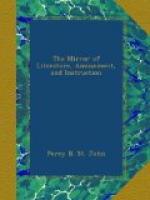“‘They are well,’ said the stranger; ’but how came you to know that I was here?’
“‘Because, sir, I saw, and do see you,’ replied the unsuspecting gossip.
“‘With which eye?’
“‘With both, to be sure,’ said she.
“‘I rather think not,’ rejoined the gentleman—’try.’
“Upon making the experiment, the poor woman discovered, to her infinite surprise, that she could only see the stranger with that eye which she had accidently rubbed with the unguent;—upon which the enraged fairy—for such he was—spitting into it, deprived it of the faculty of sight for ever!”
Of this story we have reason to believe that there are various readings, besides those of the Scotch and Welsh, and that it may be met with in England and Ireland, with slight variations and interpolations, if in no other countries.
Have our readers ever heard any fearful story of a spirit attesting the reality of its apparition, by leaving a burnt impress of fingers upon whatever it hath touched? We have heard such a tale, or rather such tales (for literally they are “legion”) from many lips, the circumstances of each being varied, but the main fact always the same: and, what is most extraordinary, always vouched for as being a portion of family history, attached to families who have not the slightest connexion with each other!—If our memory is not extremely treacherous, we believe that Sir Walter Scott, in one of his works (of which we have not the good fortune to possess a copy)—probably his “Ballads and Lyrical Pieces”—gives such a tale as a German tradition. It is, at least, extremely popular; but the Irish family of the Beresfords lay peculiar and original claim to this singular legend. Who has not heard of “The Beresford Ghost?”—Nay, but we must crave the liberty of re-publishing an oft-told tale, were it only in gratitude to some kind and esteemed Irish friends, who, believing that it might prove a novelty to several English readers, procured for us—from a lineal descendant of the family, and inheritor of the name, &c.—the following genuine and authentic document, concerning the celebrated Beresford Ghost:
“Sir Tristram Beresford was a general, in the service of King George I., who married Lady Hamilton, one of the co-heiresses of Lord Glenawley; and having large estates in the county of Tyrone, the family mansion of which was the Castle of Ballygawley, there Sir Tristram and his lady resided. Sir T. was ordered to join his regiment, then serving in Flanders;—he was severely wounded in an engagement, and reported to be dead. The means of communication with most places being in those days extremely difficult and uncertain, Lady Beresford had no means of knowing that the report of her husband’s death was premature; but firmly believing it, she married immediately, as it should seem, a young officer named Georges, to whom she had long been greatly attached. The demise of Sir Tristram Beresford did not, in fact,




